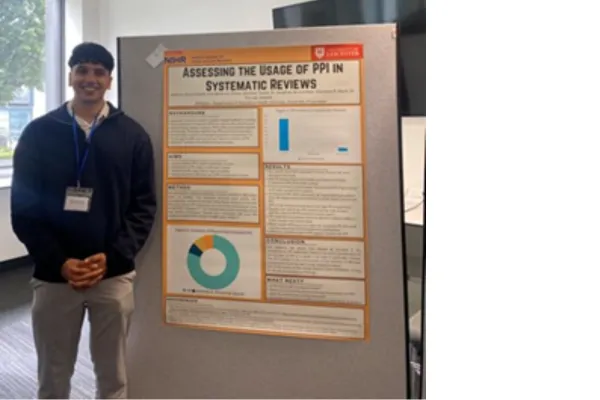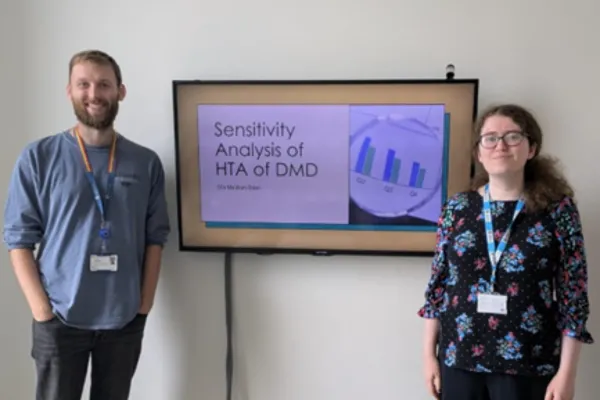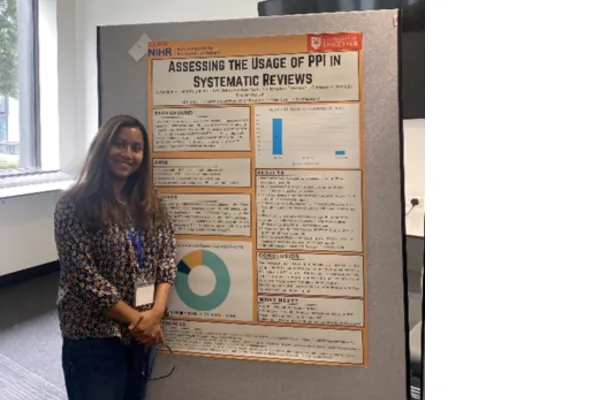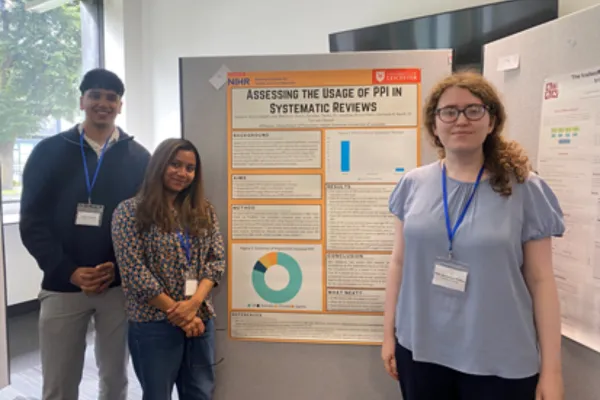Data2Health theme researchers hosted three interns for eight weeks within the Biostatistics Research Group and the TIMMS Research Group at the University of Leicester thanks to funding from the NIHR Undergraduate Internship Programme.
Through a competitive process Arjun Halaith, Eilis Meldrum-Dolan and Saraban Tanha were appointed.
They worked together on a joint team project looking at patient and public involvement in systematic reviews and independently on a small research project.
The results from the team project were presented as a poster at the Young Statisticians Meeting. This blog introduces our interns and gives an overview of the findings of their team project.
Arjun Halaith

Hi, I am Arjun – a recent Medical Physiology graduate from the University of Leicester. My background is more biological, but during my second year I took a class where I learned applications of statistical methods and models for biological analysis.
This module incorporated my biological knowledge from university and mathematical knowledge from A Levels, which I had missed learning about.
Since then, I took a year abroad at Kent State University in the US to learn more about statistical methods and how they could be applied in a medical setting and discovered the field of medical statistics, aka biostatistics.
I applied for this internship to gain hands-on experience with concepts taught at university and to experience working in the field of medical statistics.
It has also provided me with opportunities to talk to many people about the various career paths I could take in the future.
Eilis Meldrum-Dolan

I have just graduated with a BSc Hons in Mathematics at the University of Greenwich and will be starting a MSc in Statistics at King’s College London this September. I have been interested in pursuing a career in medical statistics since undertaking a placement year as a statistical programmer at UCB – a pharmaceutical company.
During my final year I became more interested in academic studies after conducting research for my project and seeing the scope of different medical research areas.
This motivated me to apply for this internship in hope of getting experience in medical statistics research, particularly from an academic perspective as opposed to what I had observed in industry.
Throughout this internship I have learned about more research methods, PPI and how to conduct a systematic review.
I got to learn about health technology assessments, rare disease research and how to conduct a sensitivity analysis in my personal project. I also got a chance to meet people who took different career paths, learn more about the day-to-day work of biostatistical research and how to further pursue it as a career in the future.
Saraban Tanha

I am currently entering the final year of my undergraduate degree studying Computer Science at Robert Gordon University.
Although my background is computing, I have always had a strong interest in public health. This interest deepened during my year-long placement at a pharmaceutical company named Amgen, where I saw how data-driven approaches support effective decision-making in healthcare.
The reason behind applying for this internship was to gain practical experience in public health research and to explore how computing skills can be applied here.
Another reason for applying is to explore whether public health could be a future career for me. During the eight weeks of internship, I have learned how research is conducted and got introduced to systematic review, meta-analysis and PPI.
For my individual project I worked on building a Shiny app to generate forest and funnel plots alongside data-exploration tools, helping to develop my skills in R Shiny with a specific focus on professional requirements.
Patient and public involvement in systematic reviews
Findings from Arjun Halaith, Eilis Meldrum-Dolan and Saraban Tanha

This targeted review aimed to explore the presence, reporting quality and reasons for the absence of PPI in systematic review articles published in the BMJ Open during 2024.
The year 2024 was chosen as it is the most recent full year. Findings from this review are compared with previous studies assessing PPI usage in systematic reviews to contextualise progress and ongoing challenges.
What is PPI?
Patient and public involvement (PPI) is a term used for research that includes patients, their family or other members of the public.
These people may contribute to research in various ways, from directing research questions to advising on data extraction and analysis or being involved in the whole research cycle from start to finish.
It is important to utilise PPI in research to make sure as researchers we are asking the right questions, looking at the right outcomes and to ensure our assumptions on patient/public needs are correct.
Often PPI usage can shine a light on areas of research that are important but commonly overlooked by researchers.
Our review
PPI usage has been proven to be useful in a multitude of cases. However, most of the time this appears to be in primary research.
Systematic reviews collate multiple primary sources and are used to direct future research.
Therefore, we believe it is important PPI is used in systematic reviews so patients and public have a say in where future research should go.
Methods
After familiarising ourselves with PPI, we conducted a literature search using PubMed filter to find systematic reviews published in Open BMJ journal in 2024. Then using Rayyan we screened the articles.
First, we all screened the same 10 articles to verify we were following the same logic then we split the remaining articles so each one would be screened by at least two people.
For any discrepancies between each reviewer’s decision to include or exclude were discussed as a group to reach a conscience.
Out of the 193 articles found in the initial search, 12 were excluded for not matching the inclusion criteria, meaning 181 went on to be reviewed.
With the screened reviews we extracted information on their country of origin, analysed full text downloads and applied the ACTIVE Framework to assess PPI usage.
The ACTIVE Framework splits a systematic into 12 stages and each stage can be in one of five degrees of PPI ranging from receiving (being told about the review) to leading (involved in key decision or even co-authors).
To ensure we were all interpreting it in the same way, we reviewed the same ten papers before split the remaining papers equally between us.
Any paper with PPI was marked to then be reviewed independently by all of us to ensure consistent usage of the framework.
We believe it is important PPI is used in systematic reviews so patients and public have a say in where future research should go.
Results
Although all the reviews contained a PPI statement within them, only 8.3 per cent reported any PPI, and of those that did not 90 per cent gave no justification.
Out of the papers with PPI, 80 per cent originated from the UK and 93 per cent had at least one UK based author.
This means the UK has far more PPI uptake than other counties with 32.4 per cent of the 37 UK based reviews incorporating PPI.
China is the only country with more papers in the BMJ Open than the UK with 43, but none of these contained PPI.
This shows that the UK’s usage of PPI is not just due to its proportion of the total reviews and is likely due to differing funding standards, such as the NHIR requiring PPI.
Only two of 15 reviews reporting PPI contained a meta-analysis as opposed to the total of systematic reviews, in which over half contained a meta-analysis.
This appears to imply more quantitative or statistically inclined reviews are less like to use PPI. This could be potentially due to concerns about explaining the research to patients and the public.
Conclusion
This review examined how PPI was reported and implemented in systematic reviews published in the BMJ Open during 2024.
Despite the journal’s policy requiring a PPI statement, most reviews reported no PPI involvement and often failed to justify its absence.
PPI inclusion often reflects funder requirements, majority of the journal containing PPI was UK-based studies as the NIHR requires inclusion of PPI for funding.
Even in studies that included PPI, the reporting was minimal, making it unclear at which stages PPI was applied.
Future research should explore PPI practices across disciplines and funding contexts to promote more consistent and meaningful integration in systematic reviews.
